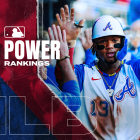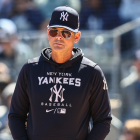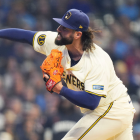The San Francisco Giants are in a tough spot.
Technically, the Giants remain in the playoff picture. They'll begin play Friday four games back in both the National League West and the hunt for the second wild-card spot. Yet the path to the postseason is more complicated than that figure indicates. The Giants are trailing three teams in the West and four in the wild-card standings. SportsLine gives them a 15.8 percent shot at cracking the tournament bracket.
Teams in the same position as the Giants tend to approach the deadline as cautious buyers. They may not go all-in, but they will consider acquiring a veteran or two for the stretch run. The calculus is more complicated for this Giants squad, however. Remember how San Francisco's front office tried its best to remain under the competitive balance tax during the winter? And how they recently dumped Austin Jackson and Cory Gearrin to save coin? The Giants, like many other teams, want to reset their penalty rate so they can play in the deep waters this winter.
So far, the Giants are succeeding in that desire -- albeit barely. Cot's Contracts tracks the unofficial tax numbers for every team. These are based on the average annual values of 40-man roster contracts, as well as $14 million for pension and benefit purposes. Based on Cot's projections, the Giants are less than $300,000 below the tax line. Remember: Cot's figures are unofficial, so San Francisco may have less room to spare than that figure presumes -- especially once injury replacements and future call-ups are factored in:
In talking with #SFGiants GM Bobby Evans, he indicated the number of DL players has pushed the team even closer to the CBT limit.
— Ahmed Fareed (@FareedNBCS) July 8, 2018
If I had to GUESS, I'd think the Giants still don't have a lot of room to add at the trade deadline.
It's fair to suggest then that the Giants could well make another trade or two before the deadline -- not in the name of chasing a postseason berth, but in order to secure their spot below the luxury tax. Whom might the Giants move in order to make that happen?
Presuming the Giants aren't going to embrace a rebuild, that takes most of their best (and highly paid) players off the board. San Francisco has 11 players who, for luxury tax purposes, account for more than $10 million. Three of those players can be deemed non-essential: outfielder Hunter Pence, starting pitcher Jeff Samardzija, and reliever Mark Melancon. The Giants aren't going to find any takers -- not with Pence looking done; Samardzija being hurt; and Melancon still having two more well-paid seasons to go on his contract. The only other player in that class who it would make any sense to consider moving is Andrew McCutchen, and there's no indication that's a possibility the Giants are weighing.
As such, if the Giants trim their payroll it'll have to come in the form of shedding a role player or two. San Francisco has plenty of options in that regard. Derek Holland, who leads the team in innings, will probably be dealt -- he'll free up less than $800,000. The Giants could ditch backup catcher Nick Hundley to save around $1 million.
Given that the Giants would presumably like to maintain their competitiveness, those are probably the least painful moves they can make. Should they dig deeper, they would presumably cut from their bullpen. Normally, Will Smith, Sam Dyson, and Tony Watson would each be locks to remain in town for at least another season. But a trade involving Dyson (around $2 million), Watson, and Smith (more than $1 million) would create more space on the ledger.
Shy of that, the Giants would have to get creative -- like, say, moving Joe Panik to a contender. That doesn't seem likely, though, given he's currently on the DL and has had a down season. Besides, the Giants can't justify putting their faith in Alen Hanson, not after 170 (admittedly good) plate appearances.
Of course, any of these moves will weaken the Giants roster and hurt their odds of reaching the postseason. But, so long as the league treats the luxury tax like a proxy salary cap, there are going to be teams who find themselves weighing whether doing all they can to compete versus saving money. The Giants are that team right now -- rest assured, they won't be the last.






















